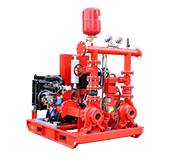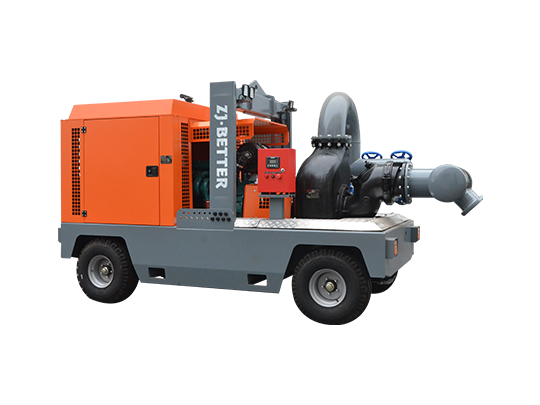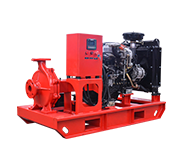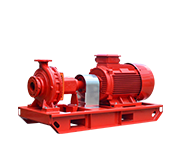The submersible sewage pump has simple installation conditions and a large flow coverage. It is one of the most commonly used lifting equipment in water treatment projects, especially small and medium-sized projects.
.jpg)
There are two common installation methods for submersible sewage pumps:
1.Coupled installation;
2. Mobile installation;
The coupled installation is to connect the pump to the pipeline through a coupler, and it is convenient to separate the pump from the outlet pipeline, and the pump can be lifted by the lifting device when it is overhauled. Coupling installation is suitable for submersible sewage pumps of various specifications, and is the most commonly used installation method for submersible sewage pumps. The coupler is supplied by the equipment manufacturer as a complete set.
Mobile installation means that the pump outlet pipeline is directly connected to the water surface through a hose, and the submersible sewage pump is reset at the bottom of the pool by itself or suspended on a lifting device through iron chains. The mobile installation does not need to be fixed by the coupler and the bottom of the pool, so it is easy to move, and it can be lifted together with the pipeline during maintenance. At the same time, due to the installation method, it is difficult to bear a large moment, so it is only suitable for small submersible sewage pumps.
1. When installing the water inlet pipe, the horizontal section may be upturned
Doing so will cause air to gather in the water inlet pipe, lower the vacuum of the water pipe and the centrifugal pump, reduce the water suction head of the centrifugal pump, and reduce the water output. The correct method is: the horizontal section should be slightly inclined to the direction of the water source, and should not be horizontal, let alone tilt upward.
2. There are many elbows used on the water inlet pipe
If there are many elbows used on the water inlet pipe, it will increase the local water flow resistance. And the elbow should turn in the vertical direction, and it is not allowed to turn in the horizontal direction, so as not to gather air.
3. Large diameter centrifugal pump with small water pipe to deliver water
Many people think that this can increase the actual head of the centrifugal pump, and the actual head of the centrifugal pump = total head - lost head. When the pump model is determined, the total head is certain; the reduction of the head mainly comes from the pipeline resistance, the smaller the pipe diameter, the greater the resistance, and the greater the loss of head, so after reducing the pipe diameter, the actual head of the centrifugal pump is not only It cannot be increased, but will decrease, resulting in a decrease in pump efficiency.
In the same way, when a small-diameter water pump uses a large water pipe to pump water, the actual head of the pump will not be reduced, but the lost head will be reduced due to the reduced resistance of the pipeline, which will increase the actual head. There are also machine owners who think that when a small-diameter water pump uses a large water pipe to pump water, it will definitely increase the load on the motor. They think that after the diameter of the pipe increases, the pressure of the water in the outlet pipe on the impeller of the pump will be greater, which will greatly increase the load on the motor. As everyone knows, the size of the liquid pressure is only related to the height of the lift, but has nothing to do with the size of the cross-sectional area of the water pipe. As long as the head is constant, the size of the impeller of the pump remains the same, no matter how big the pipe diameter is, the pressure acting on the impeller is certain. It's just that after the pipe diameter increases, the water flow resistance will decrease, so that the flow rate will increase, and the power consumption will also increase appropriately. But as long as it is within the rated head range, the pump can work normally no matter how the pipe diameter increases, and it can also reduce pipeline loss and improve pump efficiency.
4.The water inlet of the water pump is directly connected to the elbow
This will cause uneven distribution of water flow through the elbow and into the impeller. When the diameter of the water inlet pipe is larger than the water inlet of the water pump, an eccentric reducer should be installed. The flat part of the eccentric reducer should be installed on the top, and the inclined part should be installed on the bottom. Otherwise, the air will be collected, the water output will be reduced or the water will not be pumped, and there will be impact sounds. If the diameter of the water inlet pipe is equal to that of the water pump inlet, a straight pipe should be added between the water inlet of the water pump and the elbow, and the length of the straight pipe should not be less than 2 to 3 times the diameter of the water pipe.
5. The bottom section of the inlet pipe with the bottom valve is not vertical
If it is installed in this way, the valve cannot be closed by itself, resulting in water leakage. The exact installation method is: the water inlet pipe with a bottom valve, the bottom section is preferably vertical. If it cannot be installed vertically due to terrain conditions, the angle between the axis of the water pipe and the horizontal plane should be more than 60°.
6. The position of the water inlet of the water inlet pipe is wrong
When the water inlet depth of the water inlet pipe is not enough, it will cause the water surface around the water inlet pipe to generate eddies, which will affect the water inlet and reduce the water output. The accurate installation method is: the water inlet depth of small and medium-sized water pumps shall not be less than 300-600mm, and the depth of large-scale water pumps shall not be less than 600-1000mm.






